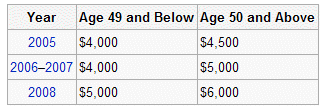Recently, there was a lot of talk going on in my office regarding IRAs and 401K. So I am going to try to unravel the mysteries behind these investment vehicles in a few posts. Today, I'm starting with Traditional IRA.
A traditional IRA is an individual retirement account (IRA). The IRA is held at a custodian such as a bank or brokerage, and may be invested in anything that the custodian allows (for instance, a bank may allow certificates of deposit, and a brokerage may allow stocks and mutual funds).
Income limits
If a taxpayer's household is covered by one or more employer-sponsored retirement plans, then the deductibility of traditional IRA contributions are phased out as specified income levels are reached.
* Married Filing Jointly or Qualified Widow and Modified Adjusted Gross Income is between $75,000 and $85,000 (this is scheduled to rise to $80,000 to $100,000 in 2007)
* Married Filing Separately (and you lived with your spouse at any time during the year) and modified AGI is between $0 and $10,000
* Single, Head of Household or Married Filing Separately (and you did not live with your spouse) and modified AGI is between $50,000 and $60,000
The lower number represents the point at which the taxpayer is still allowed to deduct the entire maximum yearly contribution. The upper number is the point as of which the taxpayer is no longer allowed to deduct at all. The deduction is reduced proportionally for taxpayers in the range. Note that people who are married and lived together, but who file separately, are only allowed to deduct a relatively small amount.
Traditional IRA contributions are limited as follows:
Tax Implications
Contributed money is at first post tax money.
However, contributions are tax deductible which reduce your tax basis for that tax year.
Then, distributions are taxed at the normal income for distributions.
Advantages
* The main advantage of a Traditional IRA is that contributions are often tax-deductible. If a taxpayer contributes $4,000 to a traditional IRA and is in the twenty-five percent marginal tax bracket, then a $1,000 benefit ($1,000 reduced tax liability) will be realized for the year. Because qualified distributions are taxed as ordinary income (the taxpayer's highest rate), the long-term benefits of the traditional IRA are only comparable to those of a Roth IRA (whose qualified distributions are tax free) if the current year tax benefit ($1,000 above) is reinvested.
* Also, if a taxpayer expects to be in a lower tax bracket in retirement than during the working years, then a traditional IRA offers an increased incentive over the Roth IRA.
* Another advantage of a Traditional IRA is that the taxpayer gets the tax benefit immediately.
Other important Facts
- Any Individual can set up a Traditonal IRA
- No matching contributions available
- Distributions can begin at age 59 1/2 or owner becomes disabled
- 10% penalty plus taxes for distributions before age 59 1/2 with exceptions
- Can withdraw up to $10k for a first time home purchase down payment with stipulations
- Can withdraw for qualified education expenses of owner, children, and grandchildren
- Can withdraw for qualified unreimbursed medical expenses that are more than 7.5% of AGI; medical insurance during period of unemployment; during disability
- Capital gains, dividends, and interest within account incur no tax liability
src="http://pagead2.googlesyndication.com/pagead/show_ads.js">
No comments:
Post a Comment